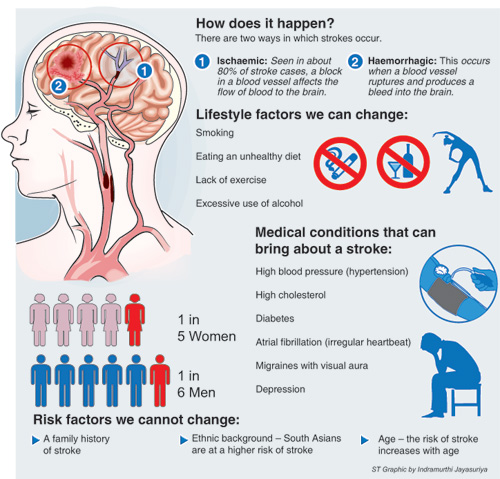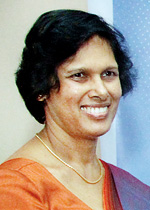From a woman to women: Beware of deadly stroke
Wife, mother, daughter, sister and friend – a woman plays her wide and varied roles with commitment and sacrifice, never faltering but at the same time giving little thought to herself.
Her time is never her own and this is the very reason that she can descend the slippery slope of illness to disability and death, if she does not take preventive measures or heed the warning signs.
 Yes, stroke does discriminate between the genders. While 1 in 6 men is prone to stroke, it is higher in women – 1 in 5 women is at risk of suffering a stroke.
Yes, stroke does discriminate between the genders. While 1 in 6 men is prone to stroke, it is higher in women – 1 in 5 women is at risk of suffering a stroke.
“Look after yourself,” is the earnest woman-to-woman plea that comes from Consultant Neuro-physician Dr. Padma Gunaratne, “for if something happens to you, the world around you will crash like a house of cards”.
The consequences then not only to the woman but all those around her would be disastrous, MediScene learns. Women face crucial issues, as stroke sufferers as well as as carers of stroke victims, the burden of which falls on them especially when their husbands are struck down by this illness.
Reiterating that stroke is preventable and treatable, Dr. Gunaratne who is the Consultant-in-Charge of the Stroke Unit of the National Hospital Colombo, is quick to urge women not to panic. She underscores that although stroke risk is low among women, at the same time it is “relatively higher” particularly in those in the 45-54 year age-group.
Stroke is a medical emergency and Dr. Gunaratne, an anti-stroke activist for a long time points out how to recognise if a woman around you has suffered a stroke. ‘FAST’ is the answer. (See graphic)
“Stroke is preventable through lifestyle management. We need to make women aware with sex-specific information on preventive practices on how to beat stroke. If unfortunately a woman suffers a stroke, she also needs to know all about accessing acute and long-term care and support,” says Dr. Gunaratne.
The facts come out clearly – women have a higher stroke mortality (death) rate than men. Six in 10 stroke deaths occur in women, she points out, due to stroke occurring later in life in women. For, women live longer and if stroke strikes you down later in life, it is more dangerous. Many of the major stroke-risk factors occur more frequently in women or are sex-specific to women, MediScene learns.
Explaining the “elevated” stroke risk factors that women have, Dr. Gunaratne picks out the ‘double dangers’:
 Pregnancy – the levels of the female hormones, oestrogen and progesterone, increase during pregnancy. This can cause changes in blood vessels and the make-up of blood. With chances that during pregnancy, blood pressure too can rise, the stroke-risk may increase.
Pregnancy – the levels of the female hormones, oestrogen and progesterone, increase during pregnancy. This can cause changes in blood vessels and the make-up of blood. With chances that during pregnancy, blood pressure too can rise, the stroke-risk may increase.
Pre-eclampsia – a serious complication of pregnancy, a problem with the placenta causes high blood pressure. If pre-eclampsia is not treated, there can be an increased stroke-risk. Use of birth control pills, especially in the case of women with high blood pressure – could bring about a small risk of getting not only stroke but also heart attacks and deep vein thrombosis. For, these pills can increase the risk of blood clots forming.
Hormone replacement therapy (HRT) after menopause – used to replace the hormones that the body has stopped producing after menopause, while HRT helps control hot flushes, vaginal dryness and mood swings, it can slightly increase the risk of stroke. This happens due to the risk of blood clots forming and also an increase in blood pressure.
Here are several other issues with regard to women and stroke that Dr. Gunaratne highlights:
Women tend to have worse stroke outcomes than men — they experience a more severe decline in cognitive function, an increased likelihood of institutionalisation and a higher risk of post-stroke depression.
nWomen as caregivers — the burden of care-giving falls predominantly on women. Research has shown that women caregivers of spouses who have suffered trauma such as stroke tend to report a decrease in mental health. They may also go into depression after becoming caregivers. This endangers women, as those with depression have a higher stroke risk.
nIsolation and loneliness — women are more likely to be widowed and living alone before a stroke and they are more often institutionalised after a stroke and have poorer recovery from stroke than men.
Women with stroke do not receive comparable care to men with stroke — women tend to be treated less well than men, despite responding equally well to stroke treatment.
There is a gender gap in stroke education — although women tend to be more aware than men of the signs and treatment of stroke, they delay going to hospital after the onset of stroke. Women are less likely to be aware of the need to seek treatment as soon as possible after a stroke as the golden window is considered to be 4½ hours.
Join hands to fight stroke, is Dr. Gunaratne’s appeal not only to women but also to men.
Explaining the “elevated” stroke risk factors that women have, Dr. Gunaratne picks out the ‘double dangers’:
Pregnancy – the levels of the female hormones oestrogen and progesterone increase during pregnancy. This can cause changes in blood vessels and the make-up of blood. With chances that during pregnancy, blood pressure too can rise, the stroke-risk may increase.
Pre-eclampsia – a serious complication of pregnancy, this is caused by a problem with the placenta. If pre-eclampsia is not treated, there can be an increased stroke-risk. Use of birth control pills, especially in the case of women with high blood pressure – there is a small risk of getting not only stroke but also heart attacks and deep vein thrombosis, as these pills can increase the risk of blood clots forming.
Hormone replacement therapy (HRT) after menopause – used to replace the hormones that the body has stopped producing after menopause, while HRT helps control hot flushes, vaginal dryness and mood swings, it can slightly increase the risk of stroke. This happens due to the risk of blood clots forming and also an increase in blood pressure.
Here are several other issues with regard to women and stroke that Dr. Gunaratne highlights:
Women tend to have worse stroke outcomes than men — they experience a more severe decline in cognitive function, an increased likelihood of institutionalisation and a higher risk of post-stroke depression.
Women as caregivers — the burden of care-giving falls predominantly on women. Research has shown that women caregivers of spouses who have suffered trauma such as stroke tend to report a decrease in mental health and going into depression after becoming caregivers. This endangers women, as those with depression have a higher stroke risk.
Isolation and loneliness — women are more likely to be widowed and living alone before a stroke and they are more often institutionalized after a stroke and have poorer recovery from stroke than men.
Women with stroke do not receive comparable care to men with stroke — women tend to be treated less well than men, despite responding equally well to stroke treatment.
There is a gender gap in stroke education — although women tend to be more aware than men of the signs and treatment of stroke, they delay going to hospital after the onset of stroke. Women are less likely to be aware of the need to seek treatment as soon as possible after a stroke as the golden window is considered to be 4½ hours.
Join hands to fight stroke, is Dr. Gunaratne’s appeal not only to women but also to men.


